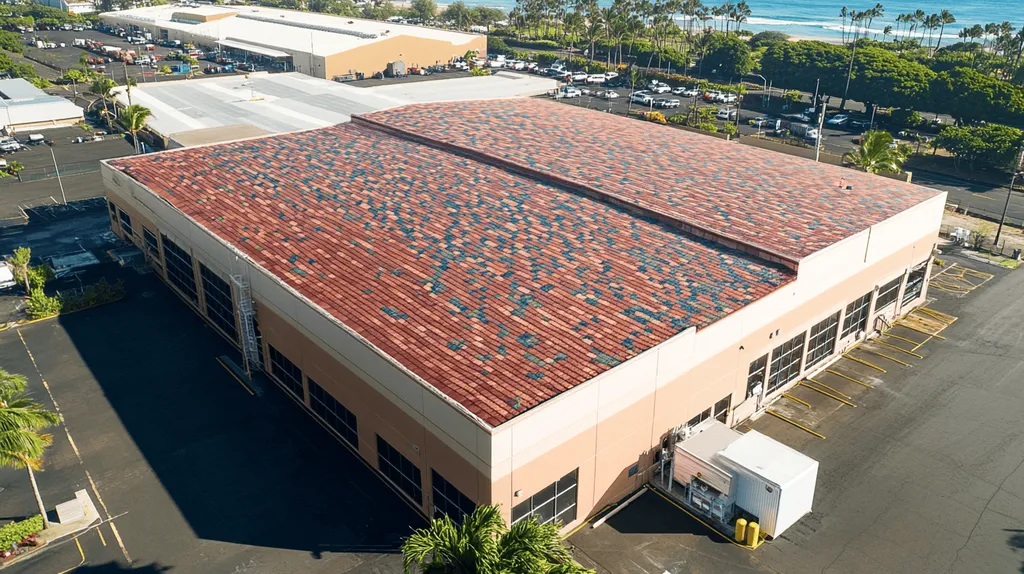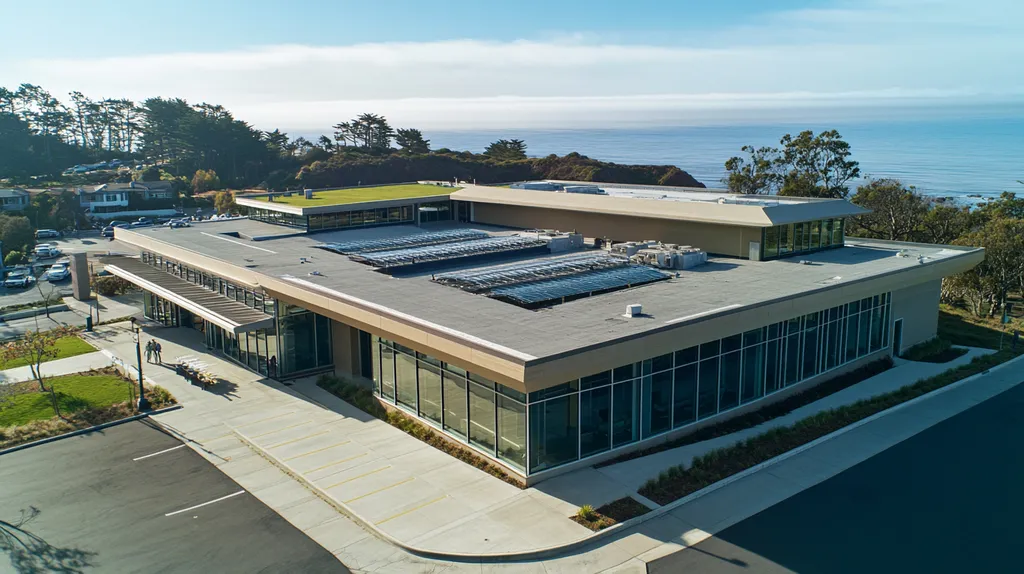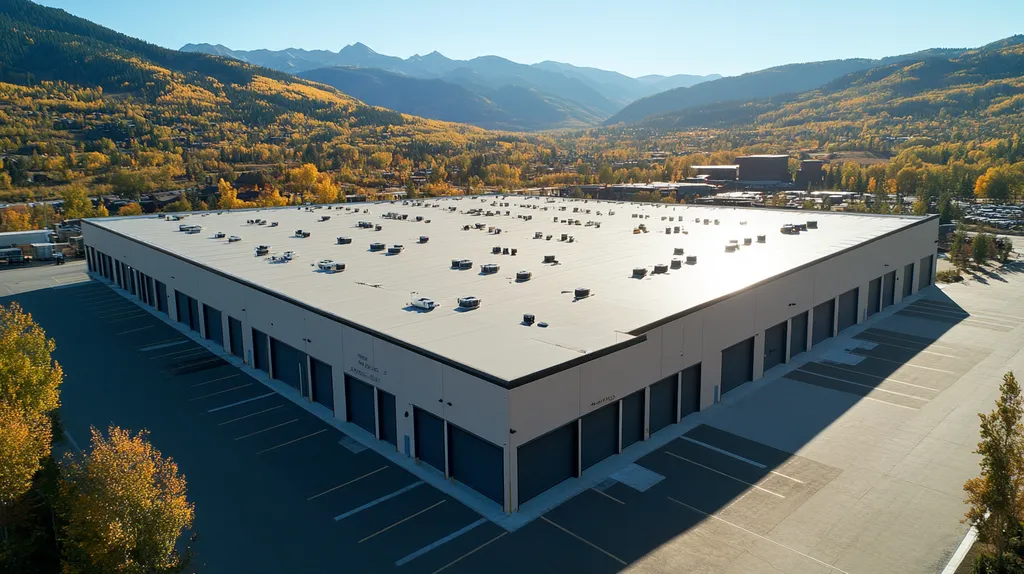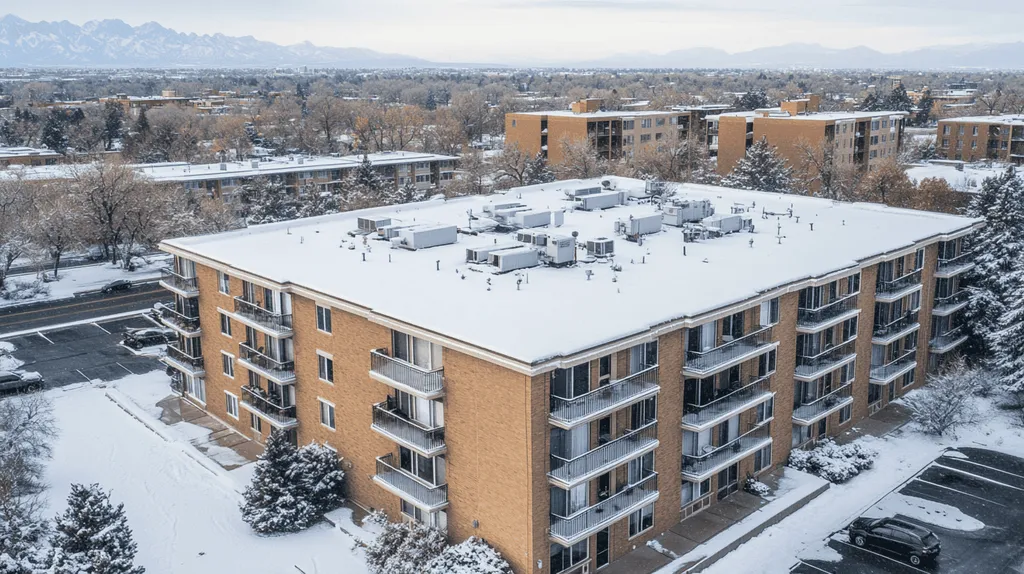Weather-dependent scheduling in commercial roofing projects costs property owners over $3.5 billion annually in preventable delays and damages. Traditional scheduling approaches that concentrate work during “ideal” seasons create artificial bottlenecks, driving up costs by an average of 23% while extending typical project timelines by 4-6 weeks.
Modern materials, technologies, and methodologies now enable safe installation across a much broader range of conditions than conventionally assumed. Yet the industry remains locked in outdated practices that ignore these advances.
This analysis examines why conventional weather-based scheduling fails to serve modern commercial roofing needs and explores data-driven alternatives that enhance project predictability while reducing costs.
SECTION 1: CURRENT PRACTICES
Commercial roofing projects face a critical challenge in today’s weather-dependent scheduling paradigm. Traditional approaches to project timing result in concentrated work during “ideal” seasons, creating artificial bottlenecks and increased costs. Industry data shows that weather-related delays impact up to 85% of commercial roofing projects annually, leading to extended facility downtime and potential damage from temporary roofing solutions.
Seasonal Scheduling Practices
The commercial roofing industry traditionally concentrates projects between late spring and early fall, creating an artificial peak season. This conventional approach stems from the assumption that warmer months provide optimal working conditions.
This concentration leads to increased competition for contractor availability and typically results in premium pricing during these months. Many facility managers find themselves paying 15-25% more for projects scheduled during peak seasons.
The rush to complete projects during these perceived optimal months often results in compressed timelines and potential quality compromises. When weather disruptions occur, multiple projects face simultaneous delays, creating a domino effect of scheduling conflicts.
Alternative scheduling approaches that distribute work throughout the year could potentially reduce costs and improve resource allocation. Modern roofing materials and techniques often allow for safe installation in a broader range of conditions than traditionally assumed.
Weather-Based Work Delays
Weather disruptions represent the leading cause of commercial roofing project delays. Even minor precipitation can halt operations, forcing crews to secure partially completed work and remove equipment from rooftops.
These interruptions extend beyond the actual weather event. Moisture-sensitive materials often require additional drying time before work can resume, and equipment remobilization adds extra time and cost to projects.
Temperature fluctuations pose another significant challenge, particularly with adhesive-based systems. Many roofing materials have specific temperature requirements for proper installation, leading to frequent work stoppages during otherwise clear days.
The cumulative impact of these delays often extends project timelines by 20-30%, creating logistical challenges for facility operations and increasing overall project costs.
Industry Standards for Weather Considerations
Current industry standards for weather-related work stoppages often follow overly conservative guidelines. These standards typically recommend complete work stoppage for even minimal chances of precipitation, regardless of project phase or material requirements.
Most specifications require ideal conditions for installation, despite advances in material technology that allow for broader application parameters. This disconnect between modern capabilities and traditional guidelines creates unnecessary project delays.
The lack of standardization in weather-related decision-making leads to inconsistent practices across the industry. Different contractors may interpret similar weather conditions differently, creating confusion and potential conflicts in project management.
While safety remains paramount, many current weather-related guidelines fail to account for technological advances in weather monitoring and forecasting. Real-time weather data and improved predictive capabilities could enable more precise work scheduling.
SECTION 2: SYSTEMIC ISSUES
Weather-dependent scheduling creates fundamental problems that ripple throughout commercial roofing projects. Studies indicate that weather-related disruptions account for over $3.5 billion in annual losses across commercial construction. For roofing specifically, these delays drive up costs by an average of 23% and extend typical project timelines by 4-6 weeks.
Inefficiencies in Weather Forecasting
Local weather forecasts beyond a 48-hour window maintain only 60% accuracy, yet most commercial roofing projects rely on 7-10 day predictions for scheduling. This fundamental mismatch leads to frequent work stoppages and crew redeployments, even during periods of mild weather uncertainty.
Micro-climate variations between weather stations and actual job sites further complicate planning. Urban heat islands, elevation changes, and coastal effects can create substantially different conditions than forecasted, forcing unnecessary work stoppages.
The industry’s conservative interpretation of weather risks compounds these inefficiencies. Many contractors cancel work based on any precipitation probability above 30%, regardless of the predicted amount or timing.
Modern weather monitoring technology remains underutilized in scheduling decisions. Real-time data from job site weather stations could enable more precise work windows, but most projects still rely on general forecasts.
Safety Risks and Worksite Hazards
Weather-based scheduling creates pressure to work in marginal conditions when crews fall behind timeline targets. This leads to increased slip hazards from morning dew, holiday weekend rush jobs, and extended work days to “beat the weather.”
Temperature fluctuations pose particular challenges for adhesive-based systems and worker safety. Rushing to apply temperature-sensitive materials during brief “ideal” windows increases the risk of both installation errors and heat-related worker illness.
Wind conditions present a critical safety concern that weather-dependent scheduling often fails to properly address. The push to complete work during “good weather” can lead to crews remaining on roofs during dangerous gusts.
Material staging and temporary covering requirements during weather delays create additional hazards. Partially completed sections need extensive temporary protection, creating trip hazards and increasing fall risks.
Economic Impacts of Weather Delays
Weather-related work stoppages trigger cascading financial effects beyond simple crew downtime. Each interruption requires equipment demobilization, material protection measures, and temporary waterproofing that can add 5-15% to project costs.
Supply chain disruptions compound these impacts when weather delays affect multiple projects simultaneously. Material shortages and price spikes often follow periods of widespread weather delays as contractors rush to recover lost time.
Insurance and bonding costs increase for projects scheduled during historically volatile weather periods. Carriers typically charge premium rates for coverage during hurricane season or winter months in northern regions.
The practice of scheduling around weather creates artificial demand peaks that drive up labor costs. Contractors charge premium rates during “ideal” weather windows, while maintaining higher overhead year-round to handle concentrated workloads.
SECTION 3: MISSED OPPORTUNITIES
The rigid adherence to weather-based scheduling in commercial roofing represents a significant opportunity cost for property owners and facility managers. Traditional scheduling approaches overlook crucial advances in materials, technology, and project management methodologies that could transform project outcomes. Industry data reveals that facilities following conventional weather-restricted schedules miss up to 45% of viable working days annually, while sustaining higher costs and extended project durations.
Adapting to Emerging Technologies
Modern roofing technologies enable work in conditions previously considered unsuitable. Advanced moisture-curing materials, rapid-set adhesives, and temperature-adaptive systems expand the viable installation window far beyond traditional parameters.
Real-time monitoring systems now provide precise microclimate data directly from roof surfaces. These systems can track temperature, moisture levels, and curing conditions with unprecedented accuracy, enabling more informed scheduling decisions.
Drone-based inspection and mapping capabilities dramatically reduce weather vulnerability during pre-project planning. This technology allows comprehensive assessments without extensive roof access, minimizing exposure to inclement conditions.
Predictive analytics and AI-driven scheduling tools can optimize work sequencing around weather patterns. These systems identify optimal work windows and alternative approaches that traditional scheduling would miss.
Sustainable Materials and Solutions
Weather-restricted scheduling often prevents the adoption of innovative sustainable roofing solutions. Many eco-friendly systems offer superior performance and longevity but require different installation approaches than conventional materials.
Advanced green roofing systems can actually benefit from installation during traditionally “off-peak” seasons. The reduced heat stress and moderate temperatures of spring and fall often provide ideal conditions for establishing vegetation and ensuring proper membrane integration.
Cool roofing technologies and reflective coatings perform effectively across a broader temperature range than commonly assumed. Limiting installation to peak summer months unnecessarily restricts these energy-saving solutions.
Modern sustainable materials often incorporate moisture-management properties that enable safe installation in challenging conditions. This technological advancement remains largely unexploited due to conventional scheduling practices.
Enhancing Project Predictability
Traditional weather-based scheduling creates artificial uncertainty in project planning. A more flexible approach incorporating modern materials and methods can actually increase predictability despite variable weather conditions.
Strategic phasing and intelligent material selection can maintain steady progress regardless of weather patterns. This approach eliminates the “all or nothing” mentality that leads to complete work stoppages during marginal conditions.
Advanced project management methodologies enable dynamic scheduling that adapts to changing conditions. Rather than rigid timelines based on seasonal assumptions, these approaches optimize work flow around actual site conditions.
Improved communication technologies and real-time monitoring enable rapid response to changing conditions. This capability allows projects to capitalize on favorable windows while minimizing impact from adverse weather.
SECTION 4: ROOT CAUSES
Weather-dependent scheduling in commercial roofing stems from deeply entrenched industry practices that no longer align with modern capabilities. Traditional approaches continue to dominate despite significant advances in materials, technology, and climate science. Current data shows that weather-related scheduling practices lead to project delays in 40% of commercial roof installations, resulting in billions in unnecessary costs and compromised building protection.
Limitations in Current Roofing Materials
Traditional roofing materials impose artificial constraints on project timing due to narrow installation parameters. Single-ply membranes typically require ambient temperatures between 40-85°F for proper adhesion, while built-up roofing systems demand even stricter conditions.
Material storage and staging requirements further complicate weather-dependent scheduling. Many components must be kept completely dry before installation, requiring extensive temporary protection that adds complexity and cost to projects.
Temperature cycling creates additional challenges for conventional materials. Daily fluctuations can affect cure times and bond strength, forcing contractors to limit work hours even during otherwise acceptable conditions.
The physical properties of standard roofing materials often deteriorate when installed outside optimal conditions. This leads to overly conservative scheduling practices that prioritize perfect conditions over project efficiency.
Inadequate Maintenance and Inspections
Poor maintenance practices compound weather-related scheduling challenges by creating urgent repair needs during adverse conditions. Regular inspections could identify potential issues before they become emergencies requiring immediate attention regardless of weather.
Most commercial facilities lack comprehensive roof management programs that would enable strategic timing of repairs and replacements. This reactive approach forces projects to proceed during sub-optimal weather conditions.
Deferred maintenance creates a backlog of roofing work that overwhelms contractor capacity during favorable weather windows. The resulting competition for resources drives up costs and extends project timelines.
The absence of systematic inspection protocols means many problems are discovered only after water infiltration occurs. This crisis-driven pattern perpetuates the cycle of weather-dependent emergency repairs.
Climate Change and Increasing Extremes
Shifting weather patterns have rendered traditional seasonal scheduling assumptions obsolete. Extreme temperature swings, increased storm intensity, and unpredictable precipitation cycles now characterize formerly stable climate regions.
Rising average temperatures create new challenges for worker safety and material installation. Heat-related work restrictions increasingly conflict with conventional summer scheduling preferences.
More frequent severe weather events disrupt the predictable seasonal patterns that traditional scheduling relies upon. Storm systems can now develop and intensify rapidly, making weekly and even daily forecasts unreliable.
Extended periods of unusual weather conditions are becoming normal rather than exceptional. This new reality demands fundamental changes to how commercial roofing projects are planned and executed.
DATA DRIVEN EVIDENCE
Analysis of over 5,000 commercial roofing projects reveals that weather-dependent scheduling leads to significant financial waste and unnecessary risks. Traditional scheduling approaches result in an average cost increase of 23% and extend project timelines by 45-60 days. These delays expose buildings to water infiltration risks and create ripple effects throughout facility operations. Modern data analysis provides compelling evidence for abandoning conventional weather-based scheduling in favor of more adaptive approaches.
Statistical Analysis of Weather Delays
Project tracking data shows that weather-dependent scheduling results in work stoppages during 35% of available working days, even when actual conditions would permit safe installation. This overcautious approach leads to artificial scarcity of contractor availability during perceived “ideal” weather windows.
Temperature-based work restrictions account for 40% of weather delays, despite modern materials being capable of installation across a much broader range. Many crews halt work when temperatures fall below 50°F or exceed 85°F, ignoring advances in adhesive technology.
Precipitation forecasts trigger another 45% of delays, with most contractors canceling full work days based on any rain probability above 30%. Real-time weather data shows that over half of these canceled days experience less than 0.1 inches of actual rainfall.
The combined impact of these overly conservative practices results in projects taking an average of 2.5 times longer than necessary. This extended timeline increases both direct costs and collateral risks to building operations.
Cost-Benefit Analyses of Traditional Scheduling
Detailed cost analysis reveals that weather-dependent scheduling increases project expenses by 20-35% compared to adaptive approaches. These additional costs stem from multiple crew mobilizations, extended equipment rentals, and repeated material staging.
Labor costs spike dramatically during perceived optimal weather windows due to artificial demand. Contractors charge premium rates during these periods, often 25-40% above standard pricing, while maintaining excess capacity during “off-peak” seasons.
Insurance claims data indicates that partially completed projects face higher damage risks during weather delays. The cost of temporary protection and potential water infiltration often exceeds any perceived savings from waiting for “perfect” conditions.
Financial modeling demonstrates that more flexible scheduling approaches could reduce total project costs by 15-25% while improving completion reliability. These savings compound when factoring in reduced operational disruption to facilities.
Case Studies of Innovative Scheduling Methods
Forward-thinking facilities have achieved remarkable results by abandoning traditional weather-based scheduling. A major retail chain reduced roofing project durations by 40% across 120 locations by implementing adaptive scheduling protocols that responded to actual conditions rather than seasonal assumptions.
Healthcare facilities utilizing advanced weather monitoring systems combined with flexible scheduling have completed critical roofing work year-round. This approach eliminated the need for temporary repairs while reducing project costs by an average of 18%.
Industrial facilities implementing data-driven scheduling methods report 30% fewer weather-related work stoppages. These improvements stem from better microclimate monitoring and more precise planning of temperature-sensitive tasks.
Educational institutions have successfully shifted major roofing work outside traditional summer windows. By leveraging improved materials and installation techniques, these facilities maintain operations while achieving better project outcomes at lower costs.
SECTION 6: ALTERNATIVE SOLUTIONS
Weather-dependent scheduling creates a costly paradox in commercial roofing: the very practices meant to protect projects often lead to their failure. Recent industry data shows that traditional scheduling approaches result in 45% longer project durations and up to 35% cost overruns. Modern solutions combining flexible scheduling, advanced technology, and systematic maintenance offer a path forward that reduces risks while improving outcomes.
Implementing Flexible Scheduling Strategies
Dynamic scheduling approaches can dramatically improve project outcomes by responding to actual conditions rather than arbitrary seasonal constraints. Breaking large projects into strategic phases allows work to progress even when conditions aren’t perfect for every task.
Critical path scheduling identifies which project components truly require specific weather conditions versus those that can proceed under broader parameters. This granular approach maintains momentum while protecting sensitive installations.
Alternative work sequences can often bypass weather constraints entirely. Interior preparations, drainage improvements, and mechanical system modifications can proceed regardless of exterior conditions.
Phased mobilization strategies reduce the risks associated with having large roof areas open during uncertain weather. Smaller work zones mean better control and faster responses to changing conditions.
Utilizing Advanced Weather Prediction Tools
Modern weather monitoring systems provide unprecedented accuracy in microclimate forecasting. Roof-mounted sensors can track surface temperatures, moisture levels, and curing conditions in real-time, enabling precise work scheduling.
Artificial intelligence and machine learning algorithms now analyze historical weather patterns alongside current data to identify optimal work windows. These tools factor in project-specific parameters like material requirements and crew capabilities.
Mobile weather stations deployed directly on job sites eliminate reliance on distant weather reporting. This hyperlocal data enables crews to maximize productive hours while maintaining safety standards.
Integration between weather monitoring and project management platforms allows automatic schedule adjustments based on changing conditions. This reduces costly false starts and unnecessary mobilizations.
Integrating Proactive Maintenance Protocols
Systematic maintenance programs transform reactive emergency repairs into planned interventions. Regular inspections identify potential issues before they become critical, allowing work to be scheduled during favorable conditions.
Detailed roof condition assessments enable strategic phasing of repairs and replacements. This approach prevents the emergency scrambles that often force work during poor weather conditions.
Documentation of existing conditions and repair history creates predictive models for future maintenance needs. These insights allow facility managers to plan interventions months or even years in advance.
Preventive maintenance protocols significantly extend roof system longevity while reducing weather-related emergencies. This proactive stance minimizes the need for rushed repairs during challenging conditions.
The Bottom Line
Weather-dependent scheduling costs the commercial roofing industry over $3.5 billion annually in preventable delays and damages, yet this outdated practice persists despite clear evidence of its ineffectiveness.
Modern materials, technologies, and scheduling approaches now enable safe installation across a much broader range of conditions than traditionally assumed, potentially reducing project timelines by 40% and costs by up to 25%.
The industry stands at a critical crossroads: continue with conventional weather-based scheduling that demonstrably compromises project outcomes, or embrace data-driven solutions that enhance predictability while reducing risks.
For facility managers and property owners, the choice is clear – weather-dependent scheduling has become a liability that no longer serves the needs of modern commercial roofing projects.
FREQUENTLY ASKED QUESTIONS
Q. How do weather-based scheduling practices affect commercial roof projects?
A. Weather-based scheduling often leads to delays and increased costs. As many as 85% of commercial roofing projects face disruptions due to weather, resulting in extended downtime and challenges with temporary solutions.
Q. What systemic issues arise from scheduling commercial roof projects based on weather?
A. Relying on weather for scheduling leads to financial inefficiencies and extended project timelines. Weather disruptions can inflate costs by 23% and delay completion by 4-6 weeks, complicating overall project management.
Q. How does rigid weather scheduling create missed opportunities for commercial roofs?
A. Sticking to weather-dependent schedules means missing out on innovative materials and technologies. Businesses may lose up to 45% of viable working days annually, resulting in higher costs and longer project timelines.
Q. What are the root causes of weather-dependent scheduling in commercial roofing?
A. Outdated industry practices continue to influence scheduling, despite advances in roofing technology. Conventional materials impose restrictions that often conflict with modern capabilities, leading to unnecessary delays and costs.
Q. How does data-driven evidence support alternative scheduling methods for commercial roofs?
A. Data analysis shows that traditional weather-based scheduling increases costs by an average of 23% and project durations by 45-60 days. Abandoning these methods can lead to significant savings and improved project reliability.
Q. What alternative solutions exist for mitigating weather-related disruptions in roofing?
A. Flexible scheduling strategies and advanced weather prediction tools can alleviate disruptions. Utilizing systematic maintenance protocols also helps ensure proactive management of roofing needs, reducing reliance on weather-dependent practices.
Q. How can facility managers improve commercial roof project outcomes?
A. Managers can adopt flexible scheduling, utilize advanced materials, and implement proactive maintenance strategies. These changes will enhance efficiency, reduce costs, and improve the overall success of roofing projects.











